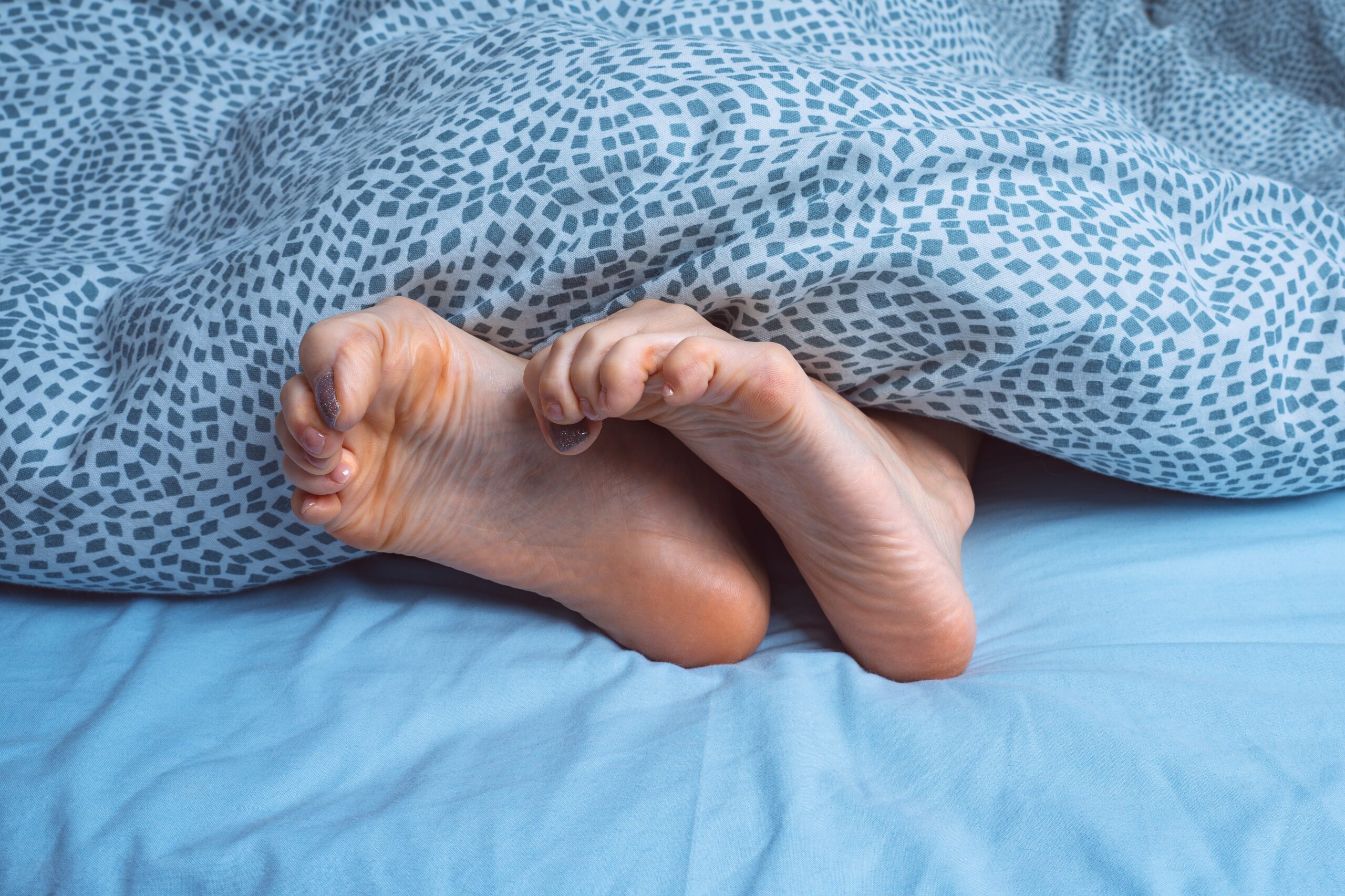The Real Story Behind Painful Legs at Night — and Your Solution
People with knee, spine, hip pain, and painful legs at night may experience it for several reasons while resting in the evening. Various factors can contribute to this condition, including osteoarthritis, sciatica, restless legs syndrome (RLS), pregnancy, and certain types of injuries or health problems that are interrelated to lower back pain management issues.
It can also occur as a result of venous insufficiency, nerve problems, muscle tension, bone, joint, tissue problems, or even basic daily stress and injury issues. According to one study, 20.9 percent of U.S. adults (51.6 million people) experienced chronic pain in 2021, and 6.9 percent (17.1 million people) experienced high-impact chronic pain causing substantial limitations in daily life.
The results of another survey show that many Americans think traditional health care providers are inadequate to manage their patients’ pain. Pain sufferers often feel stigmatized and unsupported.
If you suffer from aching legs and knees at night, you shouldn’t ignore these symptoms — especially if you are experiencing pain. Any discomfort you experience should be treated immediately.
Aging, Disorders, and Conditions Cause Painful Legs at Night
As the cartilage in your joints wear down, osteoarthritis or a host of other health conditions can start to creep in — inflicting painful legs at night. As a result, hips, knees, and your spine may experience pain, causing you to search for a lower back pain management solution.
Stiffness and inflammation are not uncommon either. When you lie down at night, your joints are less supported, which can worsen the pain, especially if it happens to be coming from osteoarthritis.
As a result of nerve irritation or compression, sciatica occurs in the lower back and down the back of the leg. A painful, numb, and tingling sensation can occur in the legs, hips, and buttocks due to this condition. Sleeping can actually worsen sciatic pain. Certain sleeping positions are more likely to compress the affected nerves.
There’s also a neurological disorder known as “restless legs syndrome” (RLS) that causes uncontrollable movements of the legs, particularly at night. An uncomfortable sensation in the legs, such as crawling, tingling, or aching, is often associated with RLS. Sleeping can be difficult due to these sensations at night.
For females, during pregnancy your legs, knees, spines, and hips can also be painful at night. Pregnancy is often associated with increased weight gain and hormonal changes. It’s also possible to experience pain at night from an injury to the legs, knees, spine, or hips. Lying down increases the likelihood that the injured tissues will swell and become inflamed.
Some Conditions Often Overlooked
Infectious diseases or aging conditions such as Lyme disease, arthritis, fibromyalgia, blood circulation problems, and medication side effects — as well as nerve disorders such as multiple sclerosis and peripheral neuropathy — can also be the cause of issues if you notice your legs hurt at night or your evenings are void of beneficial spinal pain management for back and hip problems.
A person’s worst nightmare is experiencing pain at night, whether they’re resting, sleeping, or just sitting or lying down. There’s a possibility that you may suffer from a cramp or an unfortunate injury to your muscles, bones, or nerves. Legs, knees, spines, and hips may hurt for many reasons, including trauma and underlying conditions. The symptoms of one condition can also overlap with those of another.
Whether pain occurs steadily, sporadically, or gradually in the lower extremities depends upon the individual. During certain activities or even while resting, it can suddenly strike. It may be the whole leg or only a small area that is being affected. Lower leg pain can be accompanied by a range of sensitivities, such as dull, sharp, achy or stabbing sensations, as well as numbness and burning.
Neurological, Musculoskeletal, and Vascular Issues
For some patients, nervous, musculoskeletal, and vascular issues are the most common problems contributing to painful legs at night. Restless leg syndrome, neuropathy, and sciatica are among the conditions that cause neurological pain. Nervous pain can affect your arms and legs even when you rest.
Your knee can pop or crack when it suffers from musculoskeletal pain. As it progresses, arthritis can damage your joints. Musculoskeletal pain can result from bad falls, which injure muscles, tendons, and ligaments. Musculoskeletal issues include stress fractures, compartment syndrome, and cramps.
Thrombosis, vasculitis, varicose veins, varicose eczema, or skin discoloration can also cause vascular pain in adults. Blood is supplied by your heart to muscles and organs in your body. Your legs, knees, spine, and hips require healthy valves in blood vessels to maintain blood flow. During the stretching process, a vessel’s valves become inefficient. Your vessels become clogged with deoxygenated blood, cells, and waste, causing symptoms to appear. This is one particular reason why lower back pain management remains key to solving some of these health and nighttime sleeping obstacles.
But Most of all, Vascular Issues
Poor vein circulation may also cause aching legs and knees at night. This can result in mild to severe symptoms. A lack of circulation in the veins can result in swelling, cramping, and soreness. When veins cannot transport blood and oxygen to the lower extremities, muscles and bones may suffer from lower extremity pain. In addition to being swollen and bulging, varicose veins are also painful and uncomfortable.
Various diseases of the arteries and veins affect the body’s circulatory system. With the help of your heart, your veins and arteries pump blood throughout your body. Arteries and veins transport blood to the extremities. Specifically, veins transport oxygen-depleted blood back to the heart.
The first sign of vascular disease is usually limb pain, but each person experiences it differently. There is a wide range of severity when it comes to limb pain. No matter how active or inactive you are, you can feel pain at any time. The first time you feel pain, it’s easy to ignore it and hope it’ll go away on its own. However, you should never ignore pain in your legs.
PAD, DVT, and CVI Can Contribute to Painful Legs at Night
In the lower extremities, plaque buildup can also cause painful legs at night. This is especially true when you exert your muscles repeatedly. This inflicts a great pain on your larger muscles from arterial problems. Peripheral Artery Disease (PAD) is common in the following circumstances:
PAD
As a result of fatty deposits accumulating inside the arteries, PAD hardens the arteries in the legs. Fat deposits narrow and stiffen the arteries, reducing the flow of oxygenated blood to muscles and soft tissues. There’s a tendency for limbs to suffer from poor circulation. It’s possible to improve circulation and reduce or eliminate symptoms by treating the underlying disease (arteriosclerosis in many cases). When walking, intermittent claudication appears, which disappears when lying down. The disease progresses very slowly. You may even need to seek medical attention if you experience severe pain in your lower extremities while at rest or sleeping. If your legs hurt at night, don’t delay.
DVT
Blocking blood completely or partially, venous blood clots can also cause lower extremity pain. An injury to deep veins in the legs can cause deep vein thrombosis (DVT). When a vein becomes clogged, it causes pain, tenderness, swelling, redness, warmth, and aches and stiffness in the lower body. It’s important to note, however, that some people may experience entire lower body aches, while others may not experience any symptoms at all. It can be caused by major surgery, cancer, inactivity, pregnancy, trauma, hormone replacement therapy, inflammatory and autoimmune diseases, obesity, and inherited blood diseases.
CVI and a Solution for Painful Legs at Night
When leg veins fail, blood pools in the legs and adds pressure to the vein walls. This inflames the lower extremities and causes pain. This failure of legs veins causes chronic venous insufficiency (CVI). Thrombosis and blood clots can damage blood valves or cause them to fail due to heredity. An affected leg may experience mild pain, swelling, and heaviness due to gravity. In spite of the fact that there is no danger of losing your limb, an inside ankle ulcer can be painful. As a result of these factors, CVI can be characterized and understood. As well as CVI, varicose veins can develop. Varicose veins cause pain, burning, and heaviness.
Finding a lower back pain management solution and the best treatment for hip pain at night is usually one of the best courses of action you can take. Additionally, obtaining a pain management specialist’s recommendations for spinal pain management is important. Your options should be comprehensive and inclusive of as many choices and possibilities that may (or may not) help you in finding success.
Don’t Ignore the Pain: Seek Treatment Options
Painful legs at night can be remedied with a variety of treatment options. Medical massage therapy, acupuncture, radiofrequency vein ablation, hip and knee injections, arthroscopy, platelet-rich plasma injections, anesthetic injections, and other injections can all be provided by the right health specialist through conservative treatments, minimally invasive procedures, or surgery.
It may be necessary to develop a customized care plan for each patient, based on their unique circumstances and condition. Doctors usually aim this type of plan at reducing pain, improving range of motion, and preventing injuries. They may prescribe treatments in combination based on the severity of your condition. Oftentimes, a lower back pain management plan that’s right for you is a great place to start your discussion with a pain management specialist.
A patient’s care plan is usually tailored to their unique circumstances and conditions, as well as their input. Treatment objectives always include pain relief, range of motion improvement, and injury prevention. Depending on the severity of the condition and type of intensity from your aching legs and knees at night, your doctor may recommend a combination of treatments.
Doctors perform diagnoses and treatments via minimally invasive and highly effective techniques. This effort reduces the risk of side effects and complications. Whether you suffer from mild pain or chronic pain that makes life miserable, you don’t have to live with pain.
If you are hurting and looking for an effective pain management solution, it can seem impossible to feel good. But it’s not impossible. Your quality of life can be restored by a skilled and experienced pain management doctor.
Wellness and Pain Can Help
A range of options for treating painful legs at night are available at Wellness and Pain. We offer conservative treatments, routine visits, and minimally invasive quick-recovery procedures. We can keep you free of problems by providing lifestyle education and home care advice to help you avoid and manage issues, quickly relieving the inhibiting lifestyle conditions when complications arise.
At Wellness and pain, we personalize patient care plans based on each patient’s condition. We consider unique circumstances to relieve pain, improve mobility and mental space, and improve your overall health.











